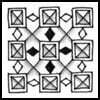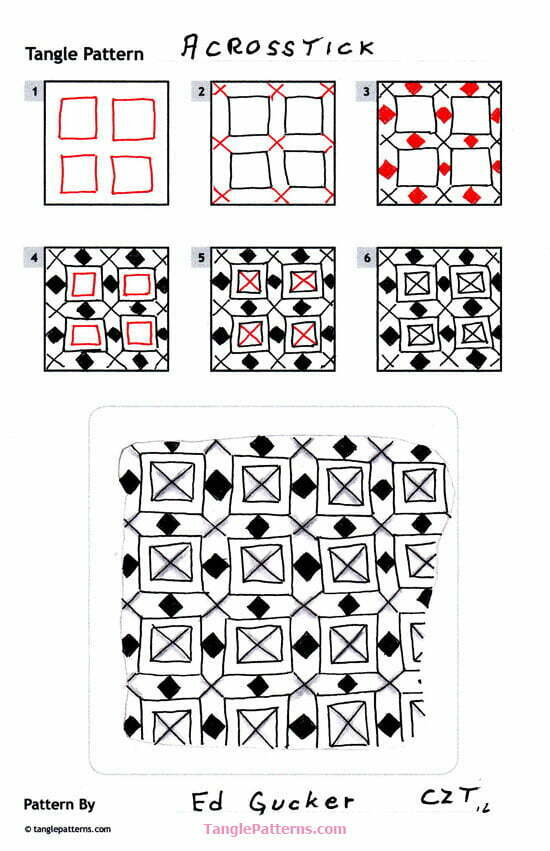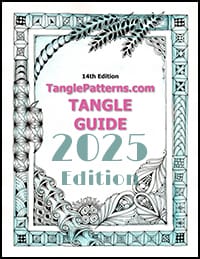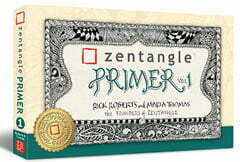 Today’s cool Acrosstick tangle is from Brockport, NY CZT Ed Gucker and it’s his first on the site.
Today’s cool Acrosstick tangle is from Brockport, NY CZT Ed Gucker and it’s his first on the site.
If you’ve been with me for a while you’ll know I usually start the week off with a super easy tangle pattern. I’m not sure Acrosstick can be called super easy, but it is not a difficult tangle to draw. The challenge is in Step 1, getting the squares square and evenly spaced to allow for the remaining elements of the tangle to be added.
Ed describes the inspiration for this tangle and its name, and includes a tip for drawing the squares.
This tangle was inspired by the fabric used to cover chairs in our local Panera restaurant. The name is a play on words: pan ~ across and era ~ period of time ~ tick.
I suggest that the squares drawn in the first step be separated by about half the length of the square’s side. This seems to generate a uniformly dense pattern.
Shading along the diagonals brings out the “drawing behind” aspect.
Ed introduces himself,
I’m a retired physicist who taught physics and astronomy at the State University of New York College at Brockport for 34 years. Patterns and diagrams are ubiquitous in teaching physics and I had developed considerable facility in drawing geometric figures. During the years before my retirement in 2000 I became interested in fractal geometry, particularly as it applies to descriptions of dynamic motion in chaotic systems. I wrote computer programs to display chaotic behavior in graphical form. After I retired, I became involved in long-arm quilting, which again creates patterns (in thread) on fabric. Many of these patterns are “formulaic” as Rick would say and can probably be revived as tangles, although the one I submitted did not come about this way.
When my wife, Judy, became interested in Zentangle, I watched with some interest and even tried a few tiles on my own, without any formal training. Then Judy went off to Providence in 2013 to become a CZT. She came home so supercharged that I decided I had better follow suit, so I completed my CZT training in 2014 (Class #16). We are now setting out to team teach ala Maria and Rick, and have just begun teaching an eight week course through our local school district’s continuing education department. We also have scheduled another three week course through a branch of the Rochester Public Library system, starting in late March. Life is good.
Drawing squares in a continuous stroke is difficult for me because my right thumb is getting more and more uncooperative to the point now that I have trigger thumb and severe tendonitis. And it tends to either lock up or jump around when it wants to, especially “turning corners” with my Micron. Ouch. I have great empathy for those of you with arthritis.
The way I dealt with the thumb issue was to draw all the lines in one direction first in Step 1, then turn my tile and connect them up into squares with strokes all going in the same direction. That way there was no need to force my thumb into a bend it didn’t want to make.
Ed illustrates the step-by-step instructions for drawing Acrosstick and shows it here in a monotangle.

Image copyright the artist and used with permission, ALL RIGHTS RESERVED. You may use this image for your personal non-commercial reference only. Republishing or redistributing pattern deconstructions in any form is prohibited under law without express permission of the copyright owner. For more information, click on the image for the article “Pinterest – How could something so right be so wrong?”.
Check out the tag edg for more of Ed’s tangles on TanglePatterns.com.
|
.oOo. |
|
Enhance your Zentangle experience while supporting TanglePatterns: |
|
LATEST EDITION! TanglePatterns.com TANGLE GUIDE, 2025 Edition |
|
 |
The 14th Edition of the TanglePatterns.com TANGLE GUIDE is an instant-download 117-page interactive digital eBook/PDF containing over 2,000 tangles on the site from May 2010 through December 31, 2024. It's a great resource and a must-have digital tool for using the site. Visit the STORE > E-BOOKS page and help keep TanglePatterns.com going by getting your copy now! |
|
"Linda, Thank you! I was relying on too few and getting stuck after 3 years of daily working with Zentangle. This has inspired me to ‘begin again’ with renewed excitement." ~ Barbara R. |
|
| See the BOOK REVIEWS page for more details on its features and view a sample page. Note: this is a digital product you download immediately when you place your order, nothing will be physically mailed to you. | |
| If you're new to Zentangle® and tangling, my TanglePatterns.com BEGINNER'S GUIDE TO ZENTANGLE is just what you need to get started. Also available en Français and en Español. | |
|
|
|
 |
This is the only Zentangle book you'll ever need: the fabulous Zentangle PRIMER Vol 1. It's your CZT-in-a-book by the founders of Zentangle®. Visit the STORE tab on the top menu bar or click on the image. For more about the content and to read the rave reviews, visit the BOOK REVIEWS tab. |
| Now available in KINDLE format for $9.99. Spanish Edition here. Japanese Edition here. | |
| "Absolutely the best Zentangle Book yet! As an accomplished artist I used to think I did not need instruction on this art form. How wrong I was! My tangling improved by leaps and bounds after reading this book. If you think you have Zentangle down then you need this book more than ever!" ~ Kris H | |
|
|
|
|
.oOo. |
|








Hi Ed,
This pattern looks simple and easy so I am excited to try it. Thanks. By the way . . . . try magnets on your thumb for great pain relief and better flexibility. Any kind will help but the stronger the better.
Hi Ed,
I too live in Brockport, N.Y. Perhaps you are at Lift Bridge tomorrow 2/23/15. Like your pattern and am learning now, will add to my book. Thank you for sharing.
Hey Ed,
Very nice pattern! I too am a physics teacher, only I teach HS. It is really cutting into my drawing time! Good luck with your teaching tangling!
I am new, have had 2 lessons, but practice a lot. My right thumb hurts badly, so I started using a black Flair pen for practice, and it works, less stress, and the darkness of the ink is vivid. I learned about Flairs from the book Drawing from the Right Side of the Brain, long ago…at least I think that was it, for teaching children to draw. I am a retired first grade teacher. The flair doesn’t run when you fill in with water markers, that is why it was used there. I haven’t done that. If you are having really bad problems, give it a try. I haven’t been at it long enough to understand why a certain pen must be used….looking forward to learning more.
Hi Carolyn, I sincerely appreciate your kind effort to help with my thumb issue, however in my case it isn’t the pen that’s the problem. For me the issue is the intermittent lack of flexibility of the thumb joints which make it difficult to control a stroke.
The Sakura Micron 01 is meant to be used with very light pressure, so you should not experience pain unless you are pressing harder than it is intended to be used. You can read more about this here:
https://tanglepatterns.com/2011/06/tips-from-sakura-on-using-their-micron-pens.html
I encourage you to get a copy of my TanglePatterns.com Beginner’s Guide to Zentangle®, it explains the everything you need to know about this wonderful art form including the Zentangle Method and the reasons for using the specific tools we do.
It is Item #2 on this page: https://tanglepatterns.com/store/e-books
Cheers and happy tangling!
Thank you, Linda. I also have a problem with stroke control (mine are wobbly, shakey). When I started using Flair for art, I discovered that problem was solved (???) so continued to use it for all writing. I just thought of another thing that may help with the pressure, the pencil grips used by primary students. I will try one on my Micron. I appreciate your answer and advice….will follow through as I really enjoy this art form.